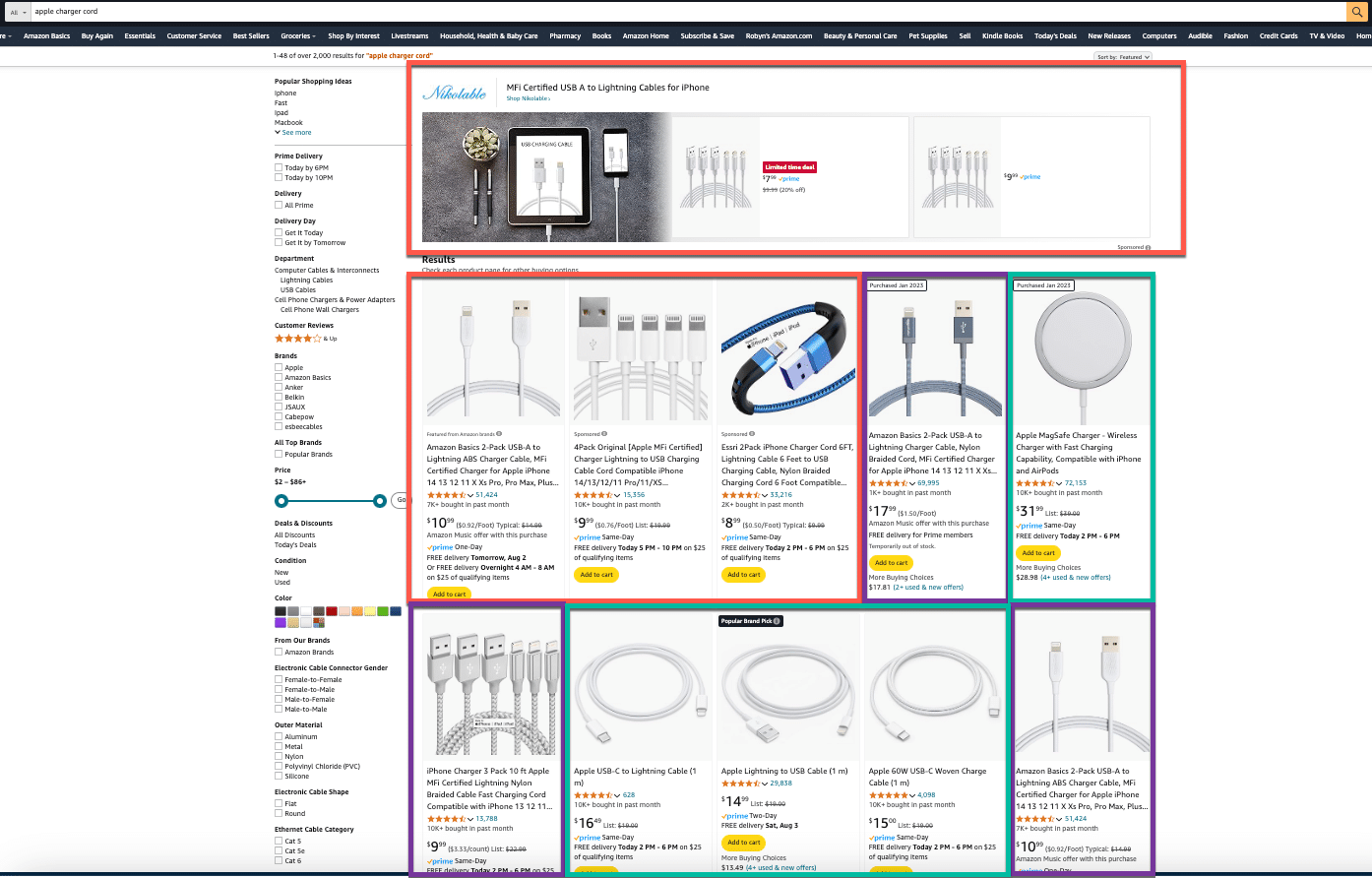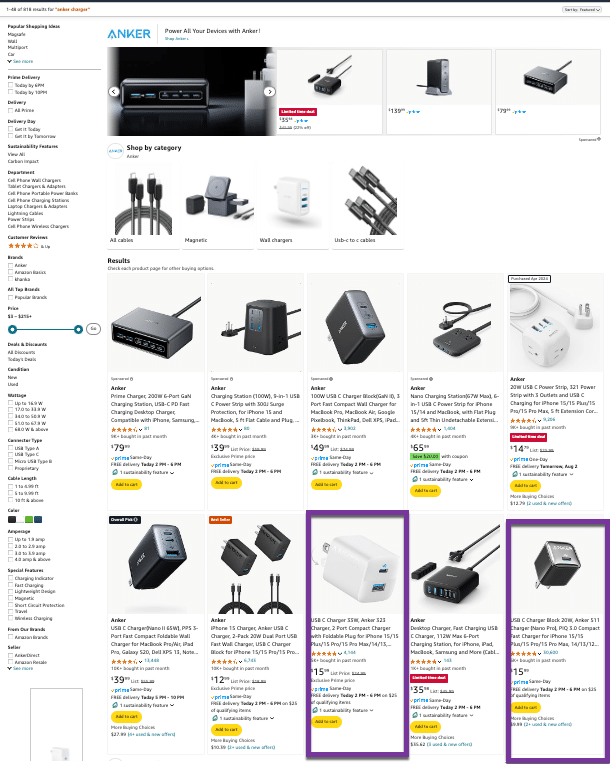Amazon and Google have several similarities regarding SEO and advertising. However, they behave very differently in some areas. One crucial area where Amazon stands apart is branded search.
Branded search refers to the specific terms and keywords closely associated with your brand. This includes:
- Your brand name.
- Product names.
- Any other trademarked phrases or slogans your customers associate tightly with your brand and use to identify and find your products on Amazon and different channels.
On Amazon, how you handle and optimize your branded search significantly impacts the visibility and performance of your products.
If you don’t optimize and protect your branded keywords in organic and paid search, your products might lose visibility. Competitors and copycats might outrank you for your primary branded keywords.
Indexing for branded search terms organically on Amazon
Indexing your branded keyword terms on Amazon will naturally occur as you include your brand and product names in the title and other structured data of the product detail pages.
You don’t need to repeat your brand name many times in Amazon listings for SEO. Only do it to give customers a consistent brand experience or to show authority and build brand affinity on the detail page.
Make sure you index for branded terms
To ensure that your Amazon listings index for important branded search terms, incorporate your brand name, trademarks and product names into the structured data, including titles, descriptions and backend keywords.
Dig deeper: 50% of product searches start on Amazon
Ranking for branded search terms on Amazon
Getting indexed is only the first step. To rank organically, you need to make sure your listing consistently converts for your branded search terms so your specific products rank for them.
Remember, there is not built-in authority at a brand level on the Amazon marketplace. This means you need to monitor the ranking of all your products for branded terms individually.
The role of branded search defense
While there are a lot of factors that go into the organic ranking of products on Amazon, we can oversimplify it to say that conversions for a specific keyword phrase over time is what has the greatest impact on organic ranking.
Protecting branded keywords
Maintaining a branded search presence is vital even for brands that don’t consider Amazon as their primary sales channel. Failure to do so could lead to your brand awareness efforts on other platforms inadvertently driving traffic to competing products on Amazon, further eroding your market share.
Even if you are an established brand, defensive use of advertising keeps other brands from drafting on the branded affinity you have built and even possibly outranking you.
“We took the foot off the gas for branded Sponsored Product ads on Amazon while I was at LEGO. A copycat brand ended up with the number one clicked product when people searched for LEGO because they won the top of search so often.”
– Josh Justice, Division Portfolio Manager, Infinite Commerce
If a competitor drives more conversions for your branded keywords, they might outrank you in the search results, even if they sell an inferior or unrelated product. If they aren’t using branded search defensive ads, it can be a highly effective customer acquisition strategy.
“Anyone that actually shops on Amazon would realize that if someone searches for a brand and the entire page of banners and listings are OTHER brands, that some amount of sales will bleed away before people ever scroll down to the first organic listing.
I work with brands that are the number one ORGANIC listing for some of their competitor brand terms.
Those competitors WISH they had invested in brand defense for the last two years.”
– Abe C. Chomali, Founder, XP Strategy


Dig deeper: Amazon Ads in 2024: Maximizing Sponsored Brands campaigns
Concerns over wasted spend
We’ve seen how often sellers and agencies want to remove the branded search from their ad campaigns.
For those used to Google Ads, advertising to people already searching for your brand might seem like a waste of money, as they already know your company and products. This creates the concern that branded search ads are simply cannibalizing organic sales.
However, over time, we find that once you remove those branded search terms, you lose those essential keyword searches within several weeks to a few months, and then you start to see a more significant dip in overall performance.
Even if you have a branded search and are ranking well for non-branded terms, keeping at least some branded campaigns in your advertising strategy helps increase overall performance.
While it is essential to periodically test how your ads impact organic sales and whether you’re at a place where you can reduce branded search campaigns, we rarely recommend eliminating them.
“For brands with high consumer awareness and search demand, we’ve tested turning off branded search. Our thought was that if a customer shows high intent to purchase, there was low risk of them clicking on a competitor.
However, we immediately saw sales impacted and competitors’ organic ranks jumped to the top of the page. This validated that branded spend is necessary on Amazon. To limit sales cannibalization, we try to introduce customers to new products or cross-sell rather than leading with hero products.
We also found that investing in top-of-funnel tactics to increase brand awareness on Amazon has paid high dividends. By using DSP, we engaged with in-market customers and used our brand store to inform them of our product benefits. With these tactics, brands should consider measuring branded traffic growth as their KPI rather than RoAS. We also highly recommend using AMC to see full media attribution.”
– Matt Snyder, Founder, Brands Excel
When not actively marketing on Amazon
Even for brands that don’t want to make Amazon their primary distribution channel, a brand defense strategy on Amazon is a must.
Many customers will look on Amazon for reviews and additional product information even if they first see your ad or content elsewhere.
Maintaining a presence on Amazon allows you to ensure customers who only like to purchase on Amazon don’t end up purchasing a competitor’s product.
Remember, Amazon can target branded terms on Google and send traffic to a curated list of competing products.
Putting your products on Amazon and setting up a low-cost brand campaign protects your branded search terms. This ensures you don’t lose traffic to competitors while you build brand awareness elsewhere.
Keeping branded search term campaigns separate
Separate your branded and non-branded search campaigns on Amazon. This helps you:
- See how well each is doing.
- Make better budget decisions.
- Understand how many new customers are buying your products without knowing your brand.
If you group your branded and non-branded search terms, poor-performing ads can hide behind the higher-return branded campaigns.
Let’s say Nike were to run ads for “Nike” and “running shoes” together in the same campaign:
- The term “Nike” would probably convert well and have a great return on investment and advertising cost of sales (ACOS).
- However, it could be masking underperforming terms that might be too broad and not be performing well (i.e., “running shoes”).
This separation lets you make better forecasting decisions and allocate your ad spend as you scale.
Launching products on Amazon with existing branded search volume
To see if a brand has enough recognition to use branded search for boosting initial sales, use tools like Helium 10, DataDive, or MerchantWords to check if people are already searching for the brand.
If you don’t want to use one of those tools, type your brand name into Amazon search and see if it auto-completes. This gives you a rough idea of whether people are already searching for your brand but not finding your products via branded search.
If people are already searching for your brand on Amazon, advertise on your branded terms at launch. This boosts initial sales, helps Amazon’s algorithms understand your product, increases impressions and improves ad relevance for future non-branded keyword ads.
As you navigate Amazon’s dynamic landscape, remember the unique role of branded search, a critical component of your overall ad strategy. Taking a proactive approach and leveraging your brand’s power ensures your products remain visible, competitive and at the forefront of the search results page.
Dig deeper: 6 Amazon marketing strategies to implement
Contributing authors are invited to create content for Search Engine Land and are chosen for their expertise and contribution to the search community. Our contributors work under the oversight of the editorial staff and contributions are checked for quality and relevance to our readers. The opinions they express are their own.
Source link : Searchengineland.com
